Midweek Review
Over a decade after triumph over LTTE, Lanka still troubled by Western agenda
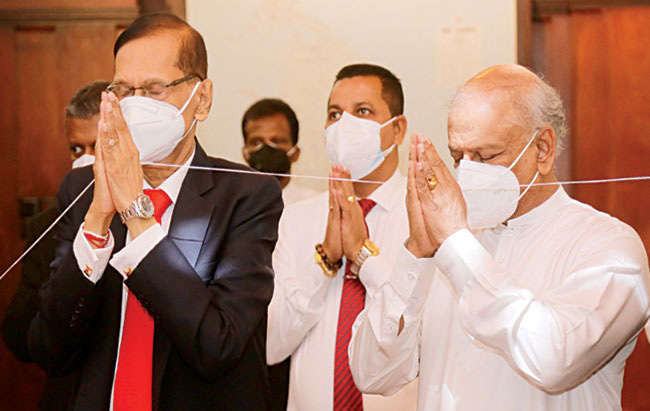
By Shamindra Ferdinando
A reference was made as regards the role played by Japanese Special Envoy Yasushi Akashi in the Norway-led peace process during Ranil Wickremesinghe’s premiership (2001-2003) when Japanese Ambassador in Colombo Akira Sugiyama paid a courtesy call on Foreign Minister Prof. G.L. Peiris on August 20.
Having won the Dec 2001 violence- marred parliamentary election, UNP leader Wickremesinghe swiftly signed the one-sided Ceasefire Agreement (CFA) with the Liberation Tigers of Tamil Eelam (LTTE) in Feb 2002, obviously prepared by the Norwegians. Even the country’s Commander-in-Chief the then President Chandrika Kumaratunga was unaware of any of the CFA terms till it was signed. The UNP leader was in such a hurry he didn’t even bother to properly consult the military before the finalisation of the CFA. Wickremesinghe and the late Velupillai Prabhakaran signed the CFA, separately.
Don’t forget the UNPer finalised the so-called peace initiative, launched by Norway, in consultation with the then President Chandrika Kumaratunga. The late Foreign Minister Lakshman Kadirgamar, too, had been involved in that initiative.
What really matters is why former Co-Chairs, having pathetically failed in their high profile project, are now pursuing an agenda targeting Sri Lanka at the Geneva-based United Nations Human Rights Council (UNHRC). What did Sri Lanka do wrong to end up at the UNHRC agenda? Didn’t the US declare UNHRC a cesspit of political bias in June 2018? The then US Ambassador there Nikki Haley declared: “For too long the Human Rights Council has been a protector of human rights abuses and a cesspool of political bias.” By whatever standards, the US is one of the worst serious human rights violators with a murderous record both in and outside the US.
Prof. Peiris, who had served as the Foreign Minister during President Mahinda Rajapaksa’s second term (2010-2015) received the foreign affairs portfolio again during the recent Cabinet reshuffle.
Prof. Peiris succeeded Rohitha Bogollagama, who switched allegiance to Kumaratunga in Nov 2004, having entered Parliament on the UNP ticket. Bogollagama, who successfully handled foreign affairs during Eelam War IV, failed to retain his seat at the 2010 general election from the Colombo District with some of the other UPFA candidates openly ganging up against him on election platforms. He contested Colombo as SLFP Organiser for Kotte, having first entered Parliament in 2000, 2001 (general election due to dissolution caused by a dozen PA MPs switching sides) and finally 2004 from Kurunegala on the UNP ticket. ‘The day Mangala issued a warning to P’karan’ in last Wednesday’s online edition of The Island dealt with how Bogollagama received the foreign affairs portfolio in Feb 2007 in the wake of the unceremonious removal of the late Samaraweera over differences with the Rajapaksas. They differed sharply on the conduct of the military strategy though that was certainly not the only contentious issue. Prof. Peiris was also in the same Cabinet.
Prof. Peiris back at FM
President Gotabaya Rajapaksa has now brought back the one time top law academic to the Foreign Ministry at the expense of Dinesh Gunawardena, who received the Education Portfolio amidst the simmering controversy over teachers’ salary issue. Switching of portfolios took place on Aug. 16 at the Presidential Secretariat. The President’s Media Division (PMD) refrained from releasing pictures of ministers taking oaths before the President. There hadn’t been a previous instance of the PMD not releasing pictures/video footage.
A Foreign Ministry statement quoted Prof. Peiris as having told Ambassador Sugiyama of what he called valuable contribution made by Akashi, now 90, in the peace negotiations and reference was also made to the Japanese role in the post-war reconciliation process and human rights issues. Foreign Secretary Admiral Prof. Jayanath Colombage was also associated with Foreign Minister Peiris at the meeting.
It is a supreme irony that the US that dropped the world’s first two atomic bombs on two highly populated cities of Hiroshima and Nagasaki to force Japan to surrender when it was already virtually on its knees unable to stop the carpet bombing by the US Air Force of the country is now an ally of Washington ready to support whatever the Americans would bid it to do.
Having finished off the LTTE in May 2009, Sri Lanka has been struggling to explain the conduct of its armed forces for having crushed ‘the most ruthless terrorist organisation’ (termed by the American Federal Bureau of Investigation) in conventional battles against the wishes of the self-appointed international community that has committed far worse crimes in an array of countries.
It would be pertinent to mention that during the Wickremesinghe premiership Prof. Peiris served as Sri Lanka’s top negotiator in the Norway-facilitated talks with the LTTE. Japan enjoyed a special status in the Oslo-led peace process that collapsed in April 2003 in the wake of the LTTE quitting the negotiating table. After the assassination of Foreign Minister Lakshman Kadirgamar in August 2005 and the abortive bid to assassinate the then Army Commander Gen. Sarath Fonseka in late April 2006, fighting erupted in the North and East in August. Had the LTTE succeeded in eliminating the then Defence Secretary Gotabaya Rajapaksa in Dec 2006, the war could have taken a different turn.
Sri Lanka brought the war to a successful conclusion in May 2009. But over a decade after the eradication of terrorism, Sri Lanka remains on politically motivated Geneva agenda with the issue coming up again later this month.
The UNHRC in March this year adopted a new resolution on Sri Lanka. The Resolution 46/1, adopted on March 23, 2021, paved the way for a powerful new accountability process to collect, analyze, and preserve evidence of international crimes committed in Sri Lanka for use in future prosecutions.The so-called Core Group comprising the United Kingdom, Canada, Germany, Malawi, Montenegro, and North Macedonia that submitted the resolution received the backing of an overwhelming majority of the 47-member UNHRC. Altogether 22 Human Rights Council members voted for the resolution at the behest of the powerful US/UK, while 11 voted against, and 14 abstained. In spite of the longstanding close relationship between Japan and Sri Lanka, the former abstained. Japan had no alternative but to conveniently abstain as it couldn’t decide on its own on the politically sensitive matter. Japan followed the US vis-a-vis Sri Lanka at the UNHRC though the solitary Super Power quit the organisation. South Korea went a step further by voting for the resolution as Seoul couldn’t ignore US dictate.
Sri Lanka should realise the Comprehensive Partnership the two countries entered into in Oct 2015 (PM Shinzo Abe and Ranil Wickremesinghe signed the agreement in Tokyo) less than a week after the yahapalana administration betrayed the military in Geneva on Oct 1, 2015 didn’t matter as Quad member Japan is politically, economically and security-wise bonded with the US. Remember, how Abe reflected on U.S. President Barack Obama’s visit in 2016 to Hiroshima. The Japanese leader asserted: “The two enemies that fought immensely 71 years ago are now bonded by the heart.”
The ongoing confrontation between China and Quad comprising the US, Japan, India and Australia has brought Sri Lanka under further pressure due to the US-led alliance taking an extremely hostile stand as regards China-Sri Lanka relationship.
Prof. Peiris and Basil Rajapaksa, who received the Finance Portfolio a couple of weeks before the mini-Cabinet reshuffle met Colombo-based envoys representing major powers. Sri Lanka, now embroiled in a severe balance of payments crisis, needs the backing of the international community and the understanding of international lending agencies, particularly the IMF. The current crisis should be examined, sensibly, against the backdrop of the economic turmoil caused by the raging Covid-19 epidemic as it caused the total collapse of the vibrant tourism industry and nose dived remittances from our expatriate workers, both of which raked in billions of dollars annually to the country. However, the SLPP government and the Opposition shouldn’t forget the country could have faced the global pandemic much better if not for the ruination of the economy caused by unbridled waste, corruption, irregularities and negligence since independence by all counts. Those who represent the SLPP and the SJB in the current parliament cannot absolve themselves of the responsibility for the present state of the national economy. Energy Minister and attorney-at-law Udaya Gammanpila should be commended for publicly warning the government of dire consequences unless remedial measures were taken. The warning was given on June 13 in the wake of SLPP demanding Gammanpila’s resignation over the sharp increase in fuel prices announced on June 11. In spite of SLPP’s vow to bring down the price of fuel once Basil Rajapaksa received the finance portfolio the ruling party quietly suppressed the issue.
Thalpahewa clarifies
 Foreign Ministry faces a daunting task in countering external challenges. Before dealing with current challenges let me mention career diplomat Chanaka Thalpahewa’s response to ‘India’s Vietnam moment, US pullout and Afghan dilemma with strapline UNP’s call to terminate diplomatic relations with Taliban questionable’ carried in August 25, 2021 online edition. Thalpahewa, who recently returned to the Foreign Ministry having served UN Habitat as head of the agency for Sri Lanka and the Maldives emphasized the pivotal importance of keeping in mind the origins of terrorism here. “There cannot be an ambiguity as regards the origins of Tamil terrorism here,” the author of Ashgate publication ‘Peaceful Intervention in Intra-State Conflicts: Norwegian Involvement in the Sri Lanka Peace Process’ Thalpahewa said. Having headed the Sri Lankan mission in London at the time of President Sirisena’s visit in early 2015 pointed out the declaration made by retired Vice Admiral G.M. Hiranandani regarding the Indian role in terrorism in Sri Lanka. VA Hiranandani authored a trilogy on the official history of the Indian Navy namely: Transition to Triumph (covering the period 1965 to 1975), Transition to Eminence (1976 to 1990), and Transition to Guardianship that covered the last decade of the twentieth century. The book that dealt with the 1976 to 1990 period confirmed the establishment of terrorist training camps in South India in 1981, two years before the first major LTTE attack on the Army in the Jaffna peninsula. The outspoken Foreign Service officer agreed with the writer’s assertion that India created an environment conducive for direct intervention here. Thalpahewa’s well researched book is a must read for those interested in knowing the truth as Sri Lanka is yet to set the record straight.
Foreign Ministry faces a daunting task in countering external challenges. Before dealing with current challenges let me mention career diplomat Chanaka Thalpahewa’s response to ‘India’s Vietnam moment, US pullout and Afghan dilemma with strapline UNP’s call to terminate diplomatic relations with Taliban questionable’ carried in August 25, 2021 online edition. Thalpahewa, who recently returned to the Foreign Ministry having served UN Habitat as head of the agency for Sri Lanka and the Maldives emphasized the pivotal importance of keeping in mind the origins of terrorism here. “There cannot be an ambiguity as regards the origins of Tamil terrorism here,” the author of Ashgate publication ‘Peaceful Intervention in Intra-State Conflicts: Norwegian Involvement in the Sri Lanka Peace Process’ Thalpahewa said. Having headed the Sri Lankan mission in London at the time of President Sirisena’s visit in early 2015 pointed out the declaration made by retired Vice Admiral G.M. Hiranandani regarding the Indian role in terrorism in Sri Lanka. VA Hiranandani authored a trilogy on the official history of the Indian Navy namely: Transition to Triumph (covering the period 1965 to 1975), Transition to Eminence (1976 to 1990), and Transition to Guardianship that covered the last decade of the twentieth century. The book that dealt with the 1976 to 1990 period confirmed the establishment of terrorist training camps in South India in 1981, two years before the first major LTTE attack on the Army in the Jaffna peninsula. The outspoken Foreign Service officer agreed with the writer’s assertion that India created an environment conducive for direct intervention here. Thalpahewa’s well researched book is a must read for those interested in knowing the truth as Sri Lanka is yet to set the record straight.
Today nuclear power India is part of the overall US strategy and like Japan is ready to counter the growing Chinese influence in the region. Here too it is an irony that the West that more or less treated India like a leper not too long ago and even attempted to break it up by lighting separatist fires across the great ancient country, from the 70’s now has become a lap dog of the US instead of holding her head high as the world’s second largest economic power before long, while Washington is self-relegating herself as a has been due to her profligacy and sheer arrogance.
Sri Lanka has been caught up in the battle between the US-led Quad and China for superiority and certainly a victim of circumstances due to its strategic positioning. The bone of contention is the increasing Chinese presence in Sri Lanka with Colombo International Container Terminals Ltd., (CICT), joint venture between China Merchants Port Holdings Company Limited and the Sri Lanka Ports Authority (SLPA), 99-year lease on the Hambantota port and the Colombo Port City being strategic investments.
Challenges faced by GR administration
Having succeeded Dinesh Gunawardena on Aug 16, Prof. Peiris received top envoys of India (skipped UK sponsored Geneva vote on Sri Lanka accountability resolution), China (voted against), US, EU, Russia (voted against), Japan (skipped), Pakistan (voted against), South Korea (voted for), Kuwait, Germany (voted for), the Netherlands (voted for), Australia, Turkey, Qatar, Norway, Vatican, Libya, UN and Italy (voted for). Unfortunately, Sri Lanka never managed to set the record straight as regards the accountability issue. Successive governments since the successful conclusion of the war in May 2009 squandered opportunities to vigorously present our case. The SLPP, too, has so far failed pathetically.
In the absence of a cohesive effort on Sri Lanka’s part, India stepped up pressure on Sri Lanka at the UNHRC with a strong reference to 13th Amendment to the Constitution forced down our throat during the Indian Army deployment in Sri Lanka’s Northern and Eastern province following the infamous ‘parippu drop’.
The UN and so-called Sri Lanka Core Group, in consultation with the Tamil National Alliance (TNA), one-time the LTTE’s sidekick worked overtime to harass Sri Lanka at Geneva. Successive governments, including the SLPP conveniently failed so far at least to officially inform the unbreakable relationship between the LTTE and the TNA until the very end. The TNA, having backed war-winning Army Commander Gen. Sarath Fonseka at the 2010 presidential election continues a despicable accountability agenda at the UNHRC. Of the five Sri Lanka Co-Group, three, namely the UK, Germany and Canada are major powers. The UK and Germany voted for the anti-Sri Lanka resolution whereas Canada backed it. Core Group bared its intentions when it raised the arrest of 2019 Easter Sunday carnage suspect Attorney-at-Law Hejaaz Hizbullah and retired Director, CID Shani Abeysekera at the UNHRC. The Foreign Ministry must examine the whole picture without being distracted by various events.
The UK is home to an influential segment of the Tamil Diaspora as well as former members of the LTTE, including Adele Balasingham, a high profile terrorist who may have been even aware of the May 1991 assassination of former Indian Prime Minister Rajiv Gandhi. Having repeatedly refused to help establish the truth by making available wartime UK diplomatic dispatches fromthe UK HC in Colombo, the UK continues to fool Sri Lanka by maintaining proscription of the LTTE in terms of the UK Terrorism Act No. 7 of 2000. The British action is meant to deceive Sri Lanka. The British ban is nothing but propaganda. Actually, the UK never restricted LTTE activity and throughout the war stood by Prabhakaran’s conventional fighting cadre. Sri Lanka Core Group members, the UK and France (voted for anti-Sri Lanka resolution) with the backing of the UN and the US made a last ditch bid in April 2009 to throw a lifeline to the LTTE. Had they succeeded, the current inoculation drive against the raging Covid-19 epidemic would have to be carried out in consultation with the LTTE. Hope, the people haven’t forgotten how the LTTE and Western powers exploited the post-tsunami situation to set up P-TOMS (Post-Tsunami Operational Management Structure) to share power with the LTTE.
Among the dignitaries, Prof. Peiris recently met included UN Resident Coordinator Hanaa Singer who has been absolutely pursuing a hostile agenda here. Having taken over the mission in Sept 2018, Singer quite clearly played politics here. She revealed her hand clearly on a number of occasions. Singer intervened on behalf of those demanding their right to bury Covid-19 victims. She went to the extent of writing to Premier Mahinda Rajapaksa over the cremation of COVID-19 victims’ bodies. Sri Lanka never properly challenged the UN mechanism used to collect information and the use of unverified data to move the 2015 accountability resolution. This Viceroy type behaviour of the UN big wigs here has been going on for far too long.
It was only the late Foreign Minister Lakshman Kadirgamar, who had the guts to tell the UN where to get off when an arrogant Norwegian who was posted here as the Resident Representative at around the beginning of the present millennium unilaterally decided to convert the UN compound in Colombo into a Tamil refugee camp soon after some serious military debacles in the North. It was obviously a premeditated attempt to create a problem situation here without there being any violence against Tamils anywhere in the South!
Those in power should be particularly ashamed for failing to challenge the confidentiality clause inserted by the UN that prevents the examination of UN (judicial or otherwise) data till 2031. We must be the only country prevented from seeing who our accusers are. All those countries voted for the resolution and abstained at the March 2021 session are involved in the plot against Sri Lanka though some did so reluctantly at the behest of the US.
In the wake of Gotabaya Rajapaksa’s triumph at the 2019 presidential election, Switzerland Embassy in Colombo with the support of political elements here staged an abduction of embassy employee Garnier Bannister Francis (formerly Siriyalatha Perera). Their project failed when President Rajapaksa thwarted the Swiss bid to evacuate Francis along with her family. The Swiss also provided political asylum to Inspector Nishantha de Silva of the CID and his family just before the trumped up abduction drama. Perhaps Prof. Peiris should take up these matters with the Swiss Ambassador when the latter pays a courtesy call on him.
Sri Lanka needs to tackle contentious issues. The country whoever is at the helm cannot turn a blind eye to contentious trumped up issues. The continuing failure on the part of the government to address the core issue raised by Lord Naseby pertaining to the veracity of the main allegation that 40,000 Tamils perished on the Vanni east front is quite baffling. Thanks to Lord Naseby’s revelation in Oct 2017 regardless of the continuing humiliation at Geneva, the world knows how the UK suppressed authentic diplomatic cables that cleared Sri Lanka of war crimes. Lord Naseby fought a near three-year legal battle to secure a section of the cables. The UK’s efforts to suppress such information are understandable as whoever in power, voters of Sri Lankan Tamil origin there cannot be antagonized. But Sri Lanka’s failure to present her case properly is much worse. The UPFA/SLPP failure on the human rights front is perhaps far worse than the UNP’s betrayal of armed forces at the UNHRC in 2015.
Sri Lanka’s disgraceful letdown should be examined against the US Defence Advisor Lt. Col. Lawrence Smith’s bombshell revelation in June 2011 that Sri Lanka military didn’t perpetrate war crimes. Perhaps, the Foreign Ministry should revisit the accountability issue again against the backdrop of the NATO pullout from Afghanistan last month that reminded us of Indian withdrawal from Sri Lanka in 1990.
Features
Handunnetti and Colonial Shackles of English in Sri Lanka
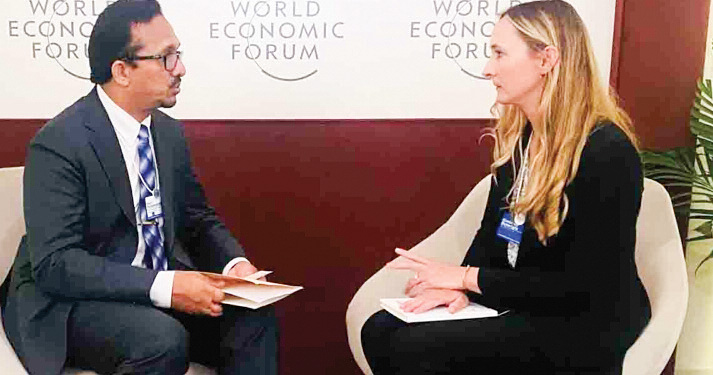
“My tongue in English chains.
I return, after a generation, to you.
I am at the end
of my Dravidic tether
hunger for you unassuaged
I falter, stumble.”
– Indian poet R. Parthasarathy
 When Minister Sunil Handunnetti addressed the World Economic Forum’s ‘Is Asia’s Century at Risk?’ discussion as part of the Annual Meeting of the New Champions 2025 in June 2025, I listened carefully both to him and the questions that were posed to him by the moderator. The subsequent trolling and extremely negative reactions to his use of English were so distasteful that I opted not to comment on it at the time. The noise that followed also meant that a meaningful conversation based on that event on the utility of learning a powerful global language and how our politics on the global stage might be carried out more successfully in that language was lost on our people and pundits, barring a few commentaries.
When Minister Sunil Handunnetti addressed the World Economic Forum’s ‘Is Asia’s Century at Risk?’ discussion as part of the Annual Meeting of the New Champions 2025 in June 2025, I listened carefully both to him and the questions that were posed to him by the moderator. The subsequent trolling and extremely negative reactions to his use of English were so distasteful that I opted not to comment on it at the time. The noise that followed also meant that a meaningful conversation based on that event on the utility of learning a powerful global language and how our politics on the global stage might be carried out more successfully in that language was lost on our people and pundits, barring a few commentaries.
Now Handunnetti has reopened the conversation, this time in Sri Lanka’s parliament in November 2025, on the utility of mastering English particularly for young entrepreneurs. In his intervention, he also makes a plea not to mock his struggle at learning English given that he comes from a background which lacked the privilege to master the language in his youth. His clear intervention makes much sense.
The same ilk that ridiculed him when he spoke at WEF is laughing at him yet again on his pronunciation, incomplete sentences, claiming that he is bringing shame to the country and so on and so forth. As usual, such loud, politically motivated and retrograde critics miss the larger picture. Many of these people are also among those who cannot hold a conversation in any of the globally accepted versions of English. Moreover, their conceit about the so-called ‘correct’ use of English seems to suggest the existence of an ideal English type when it comes to pronunciation and basic articulation. I thought of writing this commentary now in a situation when the minister himself is asking for help ‘in finding a solution’ in his parliamentary speech even though his government is not known to be amenable to critical reflection from anyone who is not a party member.
The remarks at the WEF and in Sri Lanka’s parliament are very different at a fundamental level, although both are worthy of consideration – within the realm of rationality, not in the depths of vulgar emotion and political mudslinging.
The problem with Handunnetti’s remarks at WEF was not his accent or pronunciation. After all, whatever he said could be clearly understood if listened to carefully. In that sense, his use of English fulfilled one of the most fundamental roles of language – that of communication. Its lack of finesse, as a result of the speaker being someone who does not use the language professionally or personally on a regular basis, is only natural and cannot be held against him. This said, there are many issues that his remarks flagged that were mostly drowned out by the noise of his critics.
Given that Handunnetti’s communication was clear, it also showed much that was not meant to be exposed. He simply did not respond to the questions that were posed to him. More bluntly, a Sinhala speaker can describe the intervention as yanne koheda, malle pol , which literally means, when asked ‘Where are you going?’, the answer is ‘There are coconuts in the bag’.
He spoke from a prepared text which his staff must have put together for him. However, it was far off the mark from the questions that were being directly posed to him. The issue here is that his staff appears to have not had any coordination with the forum organisers to ascertain and decide on the nature of questions that would be posed to the Minister for which answers could have been provided based on both global conditions, local situations and government policy. After all, this is a senior minister of an independent country and he has the right to know and control, when possible, what he is dealing with in an international forum.
This manner of working is fairly routine in such international fora. On the one hand, it is extremely unfortunate that his staff did not do the required homework and obviously the minister himself did not follow up, demonstrating negligence, a want for common sense, preparedness and experience among all concerned. On the other hand, the government needs to have a policy on who it sends to such events. For instance, should a minister attend a certain event, or should the government be represented by an official or consultant who can speak not only fluently, but also with authority on the subject matter. That is, such speakers need to be very familiar with the global issues concerned and not mere political rhetoric aimed at local audiences.
Other than Handunnetti, I have seen, heard and also heard of how poorly our politicians, political appointees and even officials perform at international meetings (some of which are closed door) bringing ridicule and disastrous consequences to the country. None of them are, however, held responsible.
Such reflective considerations are simple yet essential and pragmatic policy matters on how the government should work in these conditions. If this had been undertaken, the WEF event might have been better handled with better global press for the government. Nevertheless, this was not only a matter of English. For one thing, Handunnetti and his staff could have requested for the availability of simultaneous translation from Sinhala to English for which pre-knowledge of questions would have been useful. This is all too common too. At the UN General Assembly in September, President Dissanayake spoke in Sinhala and made a decent presentation.
The pertinent question is this; had Handunetti had the option of talking in Sinhala, would the interaction have been any better? That is extremely doubtful, barring the fluency of language use. This is because Handunnetti, like most other politicians past and present, are good at rhetoric but not convincing where substance is concerned, particularly when it comes to global issues. It is for this reason that such leaders need competent staff and consultants, and not mere party loyalists and yes men, which is an unfortunate situation that has engulfed the whole government.
What about the speech in parliament? Again, as in the WEF event, his presentation was crystal clear and, in this instance, contextually sensible. But he did not have to make that speech in English at all when decent simultaneous translation services were available. In so far as content was concerned, he made a sound argument considering local conditions which he knows well. The minister’s argument is about the need to ensure that young entrepreneurs be taught English so that they can deal with the world and bring investments into the country, among other things. This should actually be the norm, not only for young entrepreneurs, but for all who are interested in widening their employment and investment opportunities beyond this country and in accessing knowledge for which Sinhala and Tamil alone do not suffice.
As far as I am concerned, Handunetti’s argument is important because in parliament, it can be construed as a policy prerogative. Significantly, he asked the Minister of Education to make this possible in the educational reforms that the government is contemplating.
He went further, appealing to his detractors not to mock his struggle in learning English, and instead to become part of the solution. However, in my opinion, there is no need for the Minister to carry this chip on his shoulder. Why should the minister concern himself with being mocked for poor use of English? But there is a gap that his plea should have also addressed. What prevented him from mastering English in his youth goes far deeper than the lack of a privileged upbringing.
The fact of the matter is, the facilities that were available in schools and universities to learn English were not taken seriously and were often looked down upon as kaduwa by the political spectrum he represents and nationalist elements for whom the utilitarian value of English was not self-evident. I say this with responsibility because this was a considerable part of the reality in my time as an undergraduate and also throughout the time I taught in Sri Lanka.
Much earlier in my youth, swayed by the rhetoric of Sinhala language nationalism, my own mastery of English was also delayed even though my background is vastly different from the minister. I too was mocked, when two important schools in Kandy – Trinity College and St. Anthony’s College – refused to accept me to Grade 1 as my English was wanting. This was nearly 20 years after independence. I, however, opted to move on from the blatant discrimination, and mastered the language, although I probably had better opportunities and saw the world through a vastly different lens than the minister. If the minister’s commitment was also based on these social and political realities and the role people like him had played in negating our English language training particularly in universities, his plea would have sounded far more genuine.
If both these remarks and the contexts in which they were made say something about the way we can use English in our country, it is this: On one hand, the government needs to make sure it has a pragmatic policy in place when it sends representatives to international events which takes into account both a person’s language skills and his breadth of knowledge of the subject matter. On the other hand, it needs to find a way to ensure that English is taught to everyone successfully from kindergarten to university as a tool for inclusion, knowledge and communication and not a weapon of exclusion as is often the case.
This can only bear fruit if the failures, lapses and strengths of the country’s English language teaching efforts are taken into cognizance. Lamentably, division and discrimination are still the main emotional considerations on which English is being popularly used as the trolls of the minister’s English usage have shown. It is indeed regrettable that their small-mindedness prevents them from realizing that the Brits have long lost their long undisputed ownership over the English language along with the Empire itself. It is no longer in the hands of the colonial masters. So why allow it to be wielded by a privileged few mired in misplaced notions of elitism?
Features
Finally, Mahinda Yapa sets the record straight

Clandestine visit to Speaker’s residence:
Finally, former Speaker Mahinda Yapa Abeywardena has set the record straight with regard to a controversial but never properly investigated bid to swear in him as interim President. Abeywardena has disclosed the circumstances leading to the proposal made by external powers on the morning of 13 July, 2022, amidst a large scale staged protest outside the Speaker’s official residence, situated close to Parliament.
Lastly, the former parliamentarian has revealed that it was then Indian High Commissioner, in Colombo, Gopal Baglay (May 2022 to December 2023) who asked him to accept the presidency immediately. Professor Sunanda Maddumabandara, who served as Senior Advisor (media) to President Ranil Wickremesinghe (July 2022 to September 2024), disclosed Baglay’s direct intervention in his latest work, titled ‘Aragalaye Balaya’ (Power of Aragalaya).
Prof. Maddumabandara quoted Abeywardena as having received a startling assurance that if he agreed to accept the country’s leadership, the situation would be brought under control, within 45 minutes. Baglay had assured Abeywardena that there is absolutely no harm in him succeeding President Gotabaya Rajapaksa, in view of the developing situation.
The author told the writer that only a person who had direct control over the violent protest campaign could have given such an assurance at a time when the whole country was in a flux.
One-time Vice Chancellor of the Kelaniya University, Prof. Maddumabandara, launched ‘Aragalaye Balaya’ at the Sri Lanka Foundation on 20 November. In spite of an invitation extended to former President Gotabaya Rajapaksa, the ousted leader hadn’t attended the event, though UNP leader Ranil Wickremesinghe was there. Maybe Gotabaya felt the futility of trying to expose the truth against evil forces ranged against them, who still continue to control the despicable agenda.
Obviously, the author has received the blessings of Abeywardena and Wickremesinghe to disclose a key aspect in the overall project that exploited the growing resentment of the people to engineer change of Sri Lankan leadership.
The declaration of Baglay’s intervention has contradicted claims by National Freedom Front (NFF) leader Wimal Weerawansa (Nine: The hidden story) and award-winning writer Sena Thoradeniya (Galle Face Protest: System change for anarchy) alleged that US Ambassador Julie Chung made that scandalous proposal to Speaker Abeywardena. Weerawansa and Thoradeniya launched their books on 25 April and 05 July, 2023, at the Sri Lanka Foundation and the National Library and Documentation Services Board, Independence Square, respectively. Both slipped in accusing Ambassador Chung of making an abortive bid to replace Gotabaya Rajapaksa with Mahinda Yapa Abeywardena.
Ambassador Chung categorically denied Weerawansa’s allegation soon after the launch of ‘Nine: The hidden story’ but stopped short of indicating that the proposal was made by someone else. Chung had no option but to keep quiet as she couldn’t, in response to Weerawansa’s claim, have disclosed Baglay’s intervention, under any circumstances, as India was then a full collaborator with Western designs here for its share of spoils. Weerawansa, Thoradeniya and Maddumabandara agree that Aragalaya had been a joint US-Indian project and it couldn’t have succeeded without their intervention. Let me reproduce the US Ambassador’s response to Weerawansa, who, at the time of the launch, served as an SLPP lawmaker, having contested the 2020 August parliamentary election on the SLPP ticket.
“I am disappointed that an MP has made baseless allegations and spread outright lies in a book that should be labelled ‘fiction’. For 75 years, the US [and Sri Lanka] have shared commitments to democracy, sovereignty, and prosperity – a partnership and future we continue to build together,” Chung tweeted Wednesday 26 April, evening, 24 hours after Weerawansa’s book launch.
Interestingly, Gotabaya Rajapaksa has been silent on the issue in his memoirs ‘The Conspiracy to oust me from Presidency,’ launched on 07 March, 2024.
What must be noted is that our fake Marxists, now entrenched in power, were all part and parcel of Aragalaya.
A clandestine meeting
Abeywardena should receive the appreciation of all for refusing to accept the offer made by Baglay, on behalf of India and the US. He had the courage to tell Baglay that he couldn’t accept the presidency as such a move violated the Constitution. In our post-independence history, no other politician received such an offer from foreign powers. When Baglay stepped up pressure, Abeywardena explained that he wouldn’t change his decision.
Maddumabandara, based on the observations made by Abeywardena, referred to the Indian High Commissioner entering the Speaker’s Official residence, unannounced, at a time protesters blocked the road leading to the compound. The author raised the possibility of Baglay having been in direct touch with those spearheading the high profile political project.
Clearly Abeywardena hadn’t held back anything. The former Speaker appeared to have responded to those who found fault with him for not responding to allegations, directed at him, by revealing everything to Maddumabandara, whom he described in his address, at the book launch, as a friend for over five decades.
At the time, soon after Baglay’s departure from the Speaker’s official residence, alleged co-conspirators Ven. Omalpe Sobitha, accompanied by Senior Professor of the Sinhala Faculty at the Colombo University, Ven. Agalakada Sirisumana, health sector trade union leader Ravi Kumudesh, and several Catholic priests, arrived at the Speaker’s residence where they repeated the Indian High Commissioner’s offer. Abeywardena repeated his previous response despite Sobitha Thera acting in a threatening manner towards him to accept their dirty offer. Shouldn’t they all be investigated in line with a comprehensive probe?
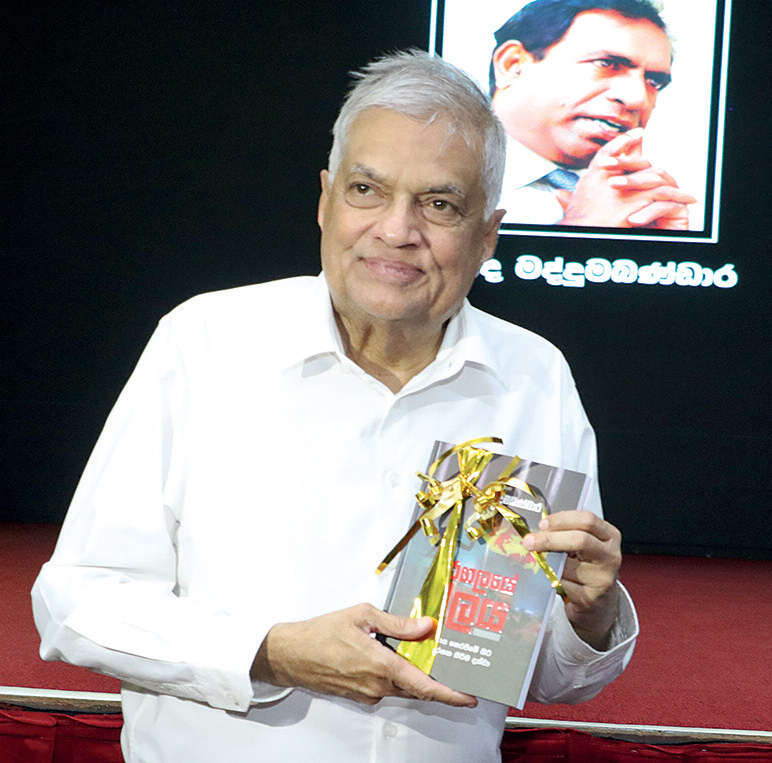
Ex-President Wickremesinghe with a copy of Aragalaye Balaya he received from its author, Prof. Professor Sunanda Maddumabandara, at the Sri Lanka Foundation recently (pic by Nishan S Priyantha)
On the basis of what Abeywardena had disclosed to him, Maddumabanadara also questioned the circumstances of the deployment of the elite Special Task Force (STF) contingent at the compound. The author asked whether that deployment, without the knowledge of the Speaker, took place with the intervention of Baglay.
Aragalaye Balaya
is a must read for those who are genuinely interested in knowing the unvarnished truth. Whatever the deficiencies and inadequacies on the part of the Gotabaya Rajapaksa administration, external powers had engineered a change of government. The writer discussed the issues that had been raised by Prof. Maddumabandara and, in response to one specific query, the author asserted that in spite of India offering support to Gotabaya Rajapaksa earlier to get Ranil Wickremesinghe elected as the President by Parliament to succeed him , the latter didn’t agree with the move. Then both the US and India agreed to bring in the Speaker as the Head of State, at least for an interim period.
If Speaker Abeywardena accepted the offer made by India, on behalf of those backing the dastardly US backed project, the country could have experienced far reaching changes and the last presidential election may not have been held in September, 2004.
After the conclusion of his extraordinary assignment in Colombo, Baglay received appointment as New Delhi’s HC in Canberra. Before Colombo, Baglay served in Indian missions in Ukraine, Russia, the United Kingdom, Nepal and Pakistan (as Deputy High Commissioner).
Baglay served in New Delhi, in the office of the Prime Minister of India, and in the Ministry of External Affairs as its spokesperson, and in various other positions related to India’s ties with her neighbours, Europe and multilateral organisations.
Wouldn’t it be interesting to examine who deceived Weerawansa and Thoradeniya who identified US Ambassador Chung as the secret visitor to the Speaker’s residence. Her high-profile role in support of the project throughout the period 31 March to end of July, 2022, obviously made her an attractive target but the fact remains it was Baglay who brought pressure on the then Speaker. Mahinda Yapa Abeywardena’s clarification has given a new twist to “Aragalaya’ and India’s diabolical role.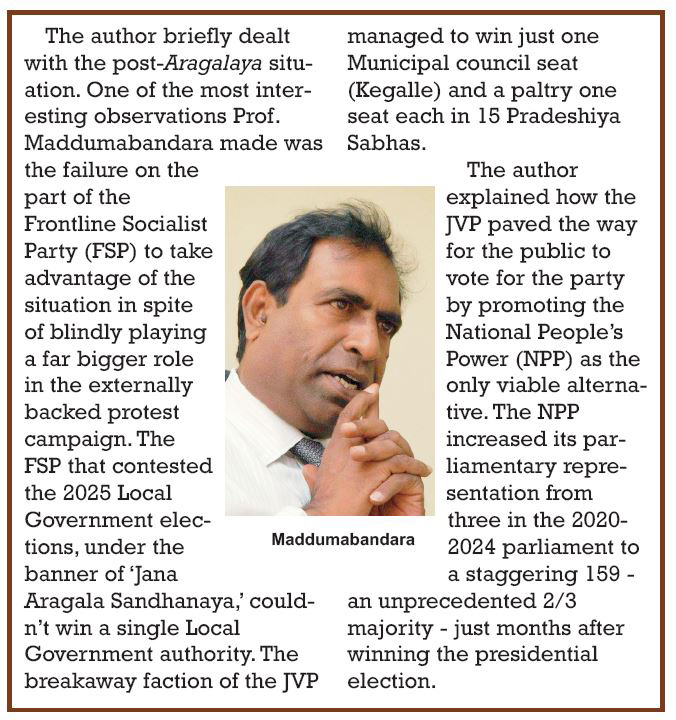
Absence of investigations
Sri Lanka never really wanted to probe the foreign backed political plot to seize power by extra-parliamentary means. Although some incidents had been investigated, the powers that be ensured that the overall project remained uninvestigated. In fact, Baglay’s name was never mentioned regarding the developments, directly or indirectly, linked to the devious political project. If not for Prof. Maddumabandara taking trouble to deal with the contentious issue of regime change, Baglay’s role may never have come to light. Ambassador Chung would have remained the target of all those who found fault with US interventions. Let me be clear, the revelation of Baglay’s clandestine meeting with the Speaker didn’t dilute the role played by the US in Gotabaya Rajapaksa’s removal.
If Prof. Maddumabandara propagated lies, both the author and Abeywardana should be appropriately dealt with. Aragalaye Balaya failed to receive the desired or anticipated public attention. Those who issue media statements at the drop of a hat conveniently refrained from commenting on the Indian role. Even Abeywardena remained silent though he could have at least set the record straight after Ambassador Chung was accused of secretly meeting the Speaker. Abeywardena could have leaked the information through media close to him. Gotabaya Rajapaksa and Ranil Wickremesinghe, too, could have done the same but all decided against revealing the truth.
A proper investigation should cover the period beginning with the declaration made by Gotabaya Rajapaksa’s government, in April 2022, regarding the unilateral decision to suspend debt repayment. But attention should be paid to the failure on the part of the government to decide against seeking assistance from the International Monetary Fund (IMF) to overcome the crisis. Those who pushed Gotabaya Rajapaksa to adopt, what they called, a domestic solution to the crisis created the environment for the ultimate collapse that paved the way for external interventions. Quite large and generous Indian assistance provided to Sri Lanka at that time should be examined against the backdrop of a larger frightening picture. In other words, India was literally running with the sheep while hunting with the hounds. Whatever the criticism directed at India over its role in regime change operation, prompt, massive and unprecedented post-Cyclone Ditwah assistance, provided by New Delhi, saved Sri Lanka. Rapid Indian response made a huge impact on Sri Lanka’s overall response after having failed to act on a specific 12 November weather alert.
It would be pertinent to mention that all governments, and the useless Parliament, never wanted the public to know the truth regarding regime change project. Prof. Maddumabandara discussed the role played by vital sections of the armed forces, lawyers and the media in the overall project that facilitated external operations to force Gotabaya Rajapaksa out of office. The author failed to question Wickremesinghe’s failure to launch a comprehensive investigation, with the backing of the SLPP, immediately after he received appointment as the President. There seems to be a tacit understanding between Wickremesinghe and the SLPP that elected him as the President not to initiate an investigation. Ideally, political parties represented in Parliament should have formed a Special Parliamentary Select Committee (PSC) to investigate the developments during 2019 to the end of 2022. Those who had moved court against the destruction of their property, during the May 2022 violence directed at the SLPP, quietly withdrew that case on the promise of a fresh comprehensive investigation. This assurance given by the Wickremesinghe government was meant to bring an end to the judicial process.
When the writer raised the need to investigate external interventions, the Human Rights Commission of Sri Lanka (HRCSL) sidestepped the issue. Shame on the so-called independent commission, which shows it is anything but independent.
Sumanthiran’s proposal
Since the eradication of the Liberation Tigers of Tamil Eelam (LTTE) in May 2009, the now defunct Tamil National Alliance’s (TNA) priority had been convincing successive governments to withdraw the armed forces/ substantially reduce their strength in the Northern and Eastern Provinces. The Illankai Thamil Arasu Kadchi (ITAK)-led TNA, as well as other Tamil political parties, Western powers, civil society, Tamil groups, based overseas, wanted the armed forces out of the N and E regions.
Abeywardena also revealed how the then ITAK lawmaker, M.A. Sumanthiran, during a tense meeting chaired by him, in Parliament, also on 13 July, 2022, proposed the withdrawal of the armed forces from the N and E for redeployment in Colombo. The author, without hesitation, alleged that the lawmaker was taking advantage of the situation to achieve their longstanding wish. The then Speaker also disclosed that Chief Opposition Whip Lakshman Kiriella and other party leaders leaving the meeting as soon as the armed forces reported the protesters smashing the first line of defence established to protect the Parliament. However, leaders of minority parties had remained unruffled as the situation continued to deteriorate and external powers stepped up efforts to get rid of both Gotabaya Rajapaksa and Ranil Wickremesinghe to pave the way for an administration loyal and subservient to them. Foreign powers seemed to have been convinced that Speaker Abeywardena was the best person to run the country, the way they wanted, or till the Aragalaya mob captured the House.
The Author referred to the role played by the media, including social media platforms, to promote Gotabaya Rajapaksa’s successor. Maddumamabandara referred to the Hindustan Times coverage to emphasise the despicable role played by a section of the media to manipulate the rapid developments that were taking place. The author also dealt with the role played by the Janatha Vimukthi Peramuna (JVP) in the project with the focus on how that party intensified its actions immediately after Gotabaya Rajapaksa stepped down.
Disputed assessment
The Author identified Ministers Bimal Rathnayaka, Sunil Handunetti and K.D. Lal Kantha as the persons who spearheaded the JVP bid to seize control of Parliament. Maddumabanda unflinchingly compared the operation, mounted against Gotabaya Rajapaksa, with the regime change operations carried out in Iraq, Libya, Egypt and Ukraine. Asserting that governments loyal to the US-led Western block had been installed in those countries, the author seemed to have wrongly assumed that external powers failed to succeed in Sri Lanka (pages 109 and 110). That assertion is utterly wrong. Perhaps, the author for some unexplained reasons accepted what took place here. Nothing can be further from the truth than the regime change operation failed (page 110) due to the actions of Gotabaya Rajapaksa, Mahinda Yapa Abeywardana and Ranil Wickremesinghe. In case, the author goes for a second print, he should seriously consider making appropriate corrections as the current dispensation pursues an agenda in consultation with the US and India.
The signing of seven Memorandums of Understanding (MoUs) with India, including one on defence, and growing political-defence-economic ties with the US, have underscored that the JVP-led National People’s Power (NPP) may not have been the first choice of the US-India combine but it is certainly acceptable to them now.
The bottom line is that a democratically elected President, and government, had been ousted through unconstitutional means and Sri Lanka meekly accepted that situation without protest. In retrospect, the political party system here has been subverted and changed to such an extent, irreparable damage has been caused to public confidence. External powers have proved that Sri Lanka can be influenced at every level, without exception, and the 2022 ‘Aragalaya’ is a case in point. The country is in such a pathetic state, political parties represented in Parliament and those waiting for an opportunity to enter the House somehow at any cost remain vulnerable to external designs and influence.
Cyclone Ditwah has worsened the situation. The country has been further weakened with no hope of early recovery. Although the death toll is much smaller compared to that of the 2004 tsunami, economic devastation is massive and possibly irreversible and irreparable.
By Shamindra Ferdinando
Features
Radiance among the Debris
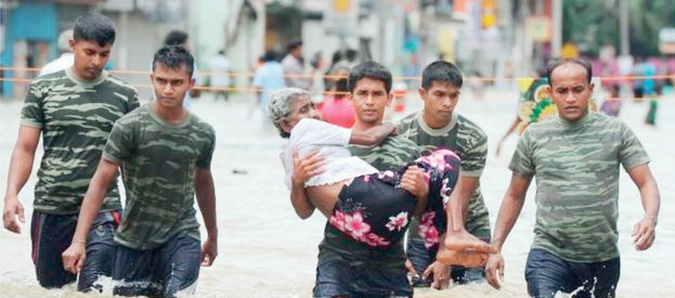
Over the desolate watery wastes,
Dulling the glow of the fabled Gem,
There opens a rainbow of opportunity,
For the peoples North and South,
To not only meet and greet,
But build a rock-solid bridge,
Of mutual help and solidarity,
As one undivided suffering flesh,
And we are moved to say urgently-
‘All you who wax so lyrically,
Of a united nation and reconciliation,
Grab this bridge-building opportunity.’
By Lynn Ockersz
-

 News3 days ago
News3 days agoOver 35,000 drug offenders nabbed in 36 days
-
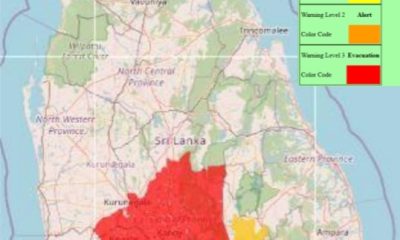
 News7 days ago
News7 days agoLevel III landslide early warning continue to be in force in the districts of Kandy, Kegalle, Kurunegala and Matale
-

 Business5 days ago
Business5 days agoLOLC Finance Factoring powers business growth
-

 News5 days ago
News5 days agoCPC delegation meets JVP for talks on disaster response
-
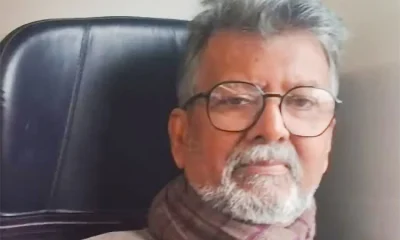
 News2 days ago
News2 days agoCyclone Ditwah leaves Sri Lanka’s biodiversity in ruins: Top scientist warns of unseen ecological disaster
-
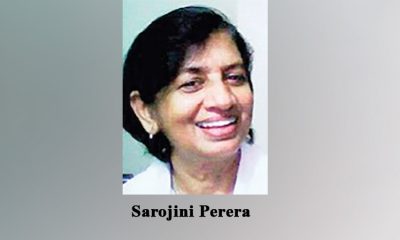
 News5 days ago
News5 days agoA 6th Year Accolade: The Eternal Opulence of My Fair Lady
-

 News3 days ago
News3 days agoRising water level in Malwathu Oya triggers alert in Thanthirimale
-
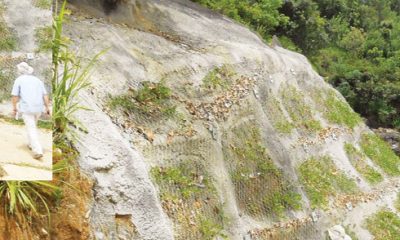
 Features4 days ago
Features4 days agoThe Catastrophic Impact of Tropical Cyclone Ditwah on Sri Lanka:













